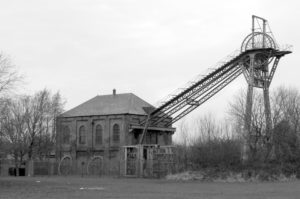Sinkhole in Gosforth costs over £300,000 to fix
25th February 2018
Recently a man-made sinkhole in Gosforth took over 7 months and cost more than £300,000 to fix
Over thousands of years man has disturbed the earth by looking for coal and other minerals.
In the North-East coal mining was prolific especially from the 1800’s onwards. The majority of mines only closed in the latter part of the twentieth century.
There are still visible signs of our coal-mining past as various collieries were converted into parkland, museums, or the buildings left as a commemoration of our industrial past.
However some signs of mining are now hidden and the shafts, adits and other grounds works has had a disastrous impact on ground stability in some areas.
A recent Channel 5 documentary series “Sinkholes” explained that there are 170,000 coal mineshafts in the UK and over 400,000 non-coal mineshafts – and less than 5% of them are capped properly in a way that wouldn’t collapse.
http://www.channel5.com/show/sinkholes/
These are not new problems but the costs involved today when a sinkhole opens are staggering, not to mention the stress and worry.
In the second episode of Channel 5’s “Sinkholes” a hole that opened up in Gosforth (Newcastle upon Tyne) was used as an example of how the costs and complications can quickly spiral out of control.
In November 2015 nearby residents woke to find that a 20ft diameter, 30ft deep sinkhole had appeared at the end of one of their driveways. It turned out to be an entrance to a disused coalmine that had been capped and forgotten about 100 years ago.
There are some photos in the Evening Chronicle: https://www.chroniclelive.co.uk/news/north-east-news/gosforth-sinkhole-recap-updates-20ft-10433348
It took 7 months to make the Gosforth sinkhole safe again at a cost of £300,000.
Think about all the inconvenience and worry caused to the nearby residents.
Property in Washington with mineshaft under the living room
Carrying out a standard Coal Authority CON29 search benefitted two of our clients a couple of years ago.
The house our clients considered purchasing was a very nicely presented and well maintained property in Washington which had been built in the last thirty years. It was close to lots of local amenities and seemed just perfect for our first time buyers.
The sellers and their estate agent did not give any warning to our client that there were any potential issues with the property and all was going ahead happily with the purchase until the CON 29 coal report showed up an adit (a horizontal passage leading into a mine for the purposes of access or drainage).
The report highlighted that the adit was right under the living room of the house and also affected the neighbouring house.
The Coal Authority warned that there were no records available to indicate how it had been capped but that it was likely to have been capped more than a hundred years ago.
A hundred or so years ago the common way to block an adit would be to throw as much wood, rubbish and anything else available down the hole to block the opening until the entrance was filled enough to be able to cap it off with rough concrete. This would mean the full extent of the adit was not filled completely.
On querying this with the sellers they admitted that annual checks were being made for subsidence.
Armed with this additional information about the property our clients decided not to proceed.
There is more information about ‘F’ Pit Colliery in Washington and other North-East mines here: http://www.dmm.org.uk/shafts/w049-01.htm
In some areas of the country, especially in the Midlands, many properties are blighted like this and can be very difficult to sell.
We recommend that you carry out a Coal search before purchasing property
We recommend that it is essential to carry out a Coal Authority search prior purchasing property in the North-East.
Most mortgage lenders need this information to be provided to them before releasing funds.
The Coal Authority holds and maintains the national coal mining database for England, Scotland and Wales.
The Con 29M report from the Coal Authority provides you with property specific information about past, present and proposed underground and surfacing coal mining activities including shrinkable clay, running sand, compressible and collapsible deposits, potential landslide activity and soluble rocks.
In addition to the CON 29 report our search provider (TM Group) also provide the following mining searches;
TerraSearch® Coal Extra :
TerraSearch® Coal Extra offers the equivalent of a regulated Coal & Brine search and is “Con29M-compliant”, whilst also alerting against an additional 55 mining hazards.
TerraSearch® Assess :
TerraSearch® Assess is a single search that comprehensively assesses the risk to a site (property and land) from all 60 mining hazards, including past, present and planned extraction.
If you are considering purchasing a property and would like more information about the searches we can conduct on your behalf prior to exchange of contracts please contact us on 0191 4555361 and ask to speak to a member of our conveyancing team.











